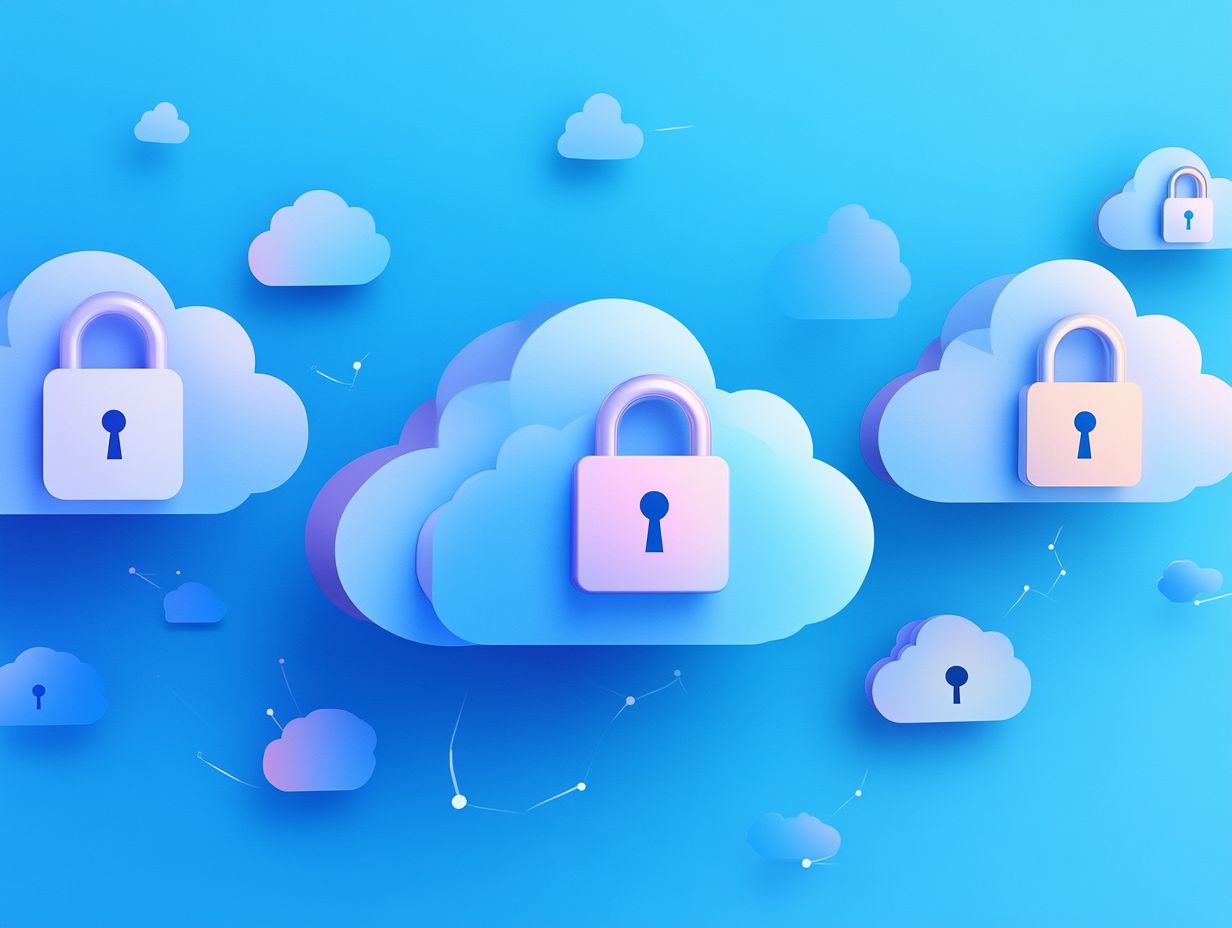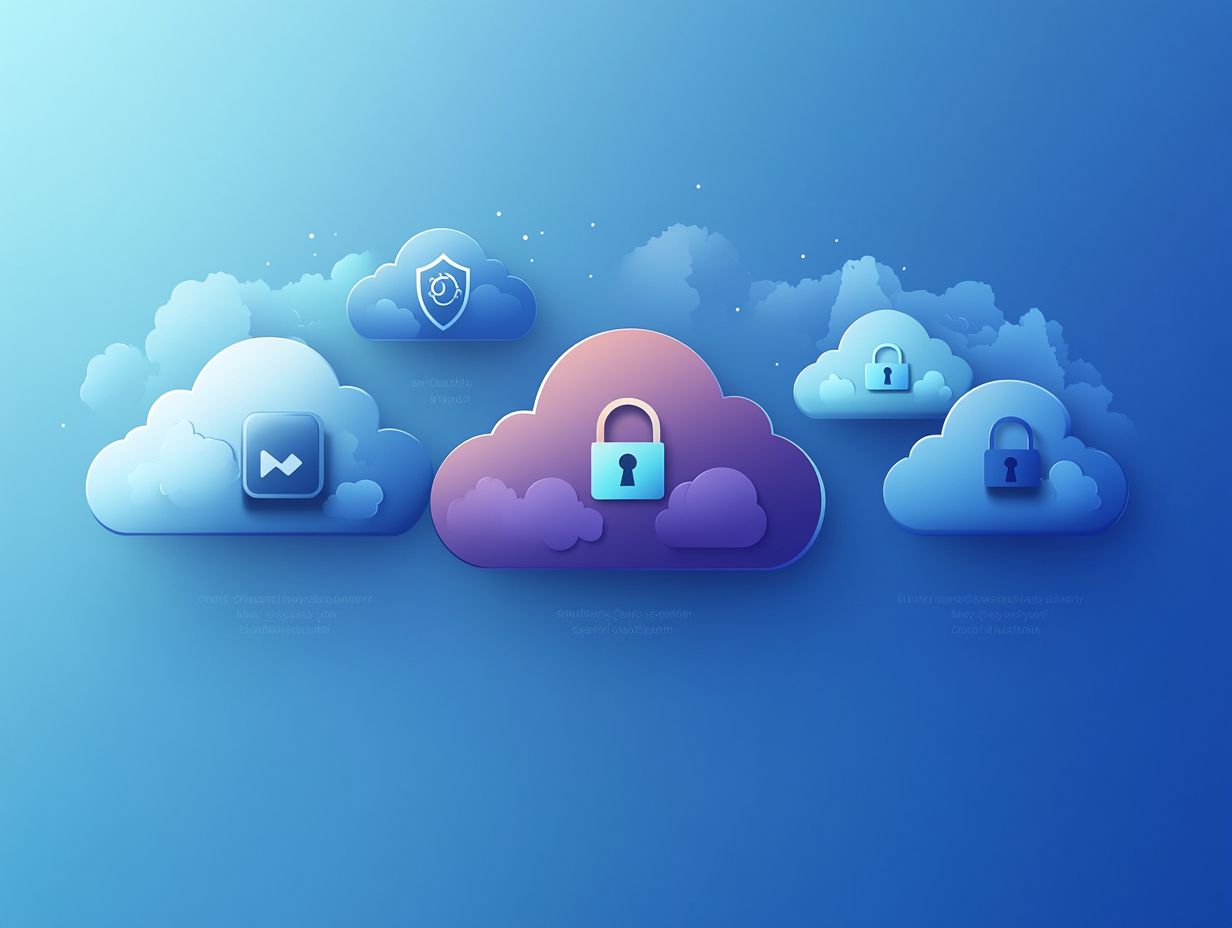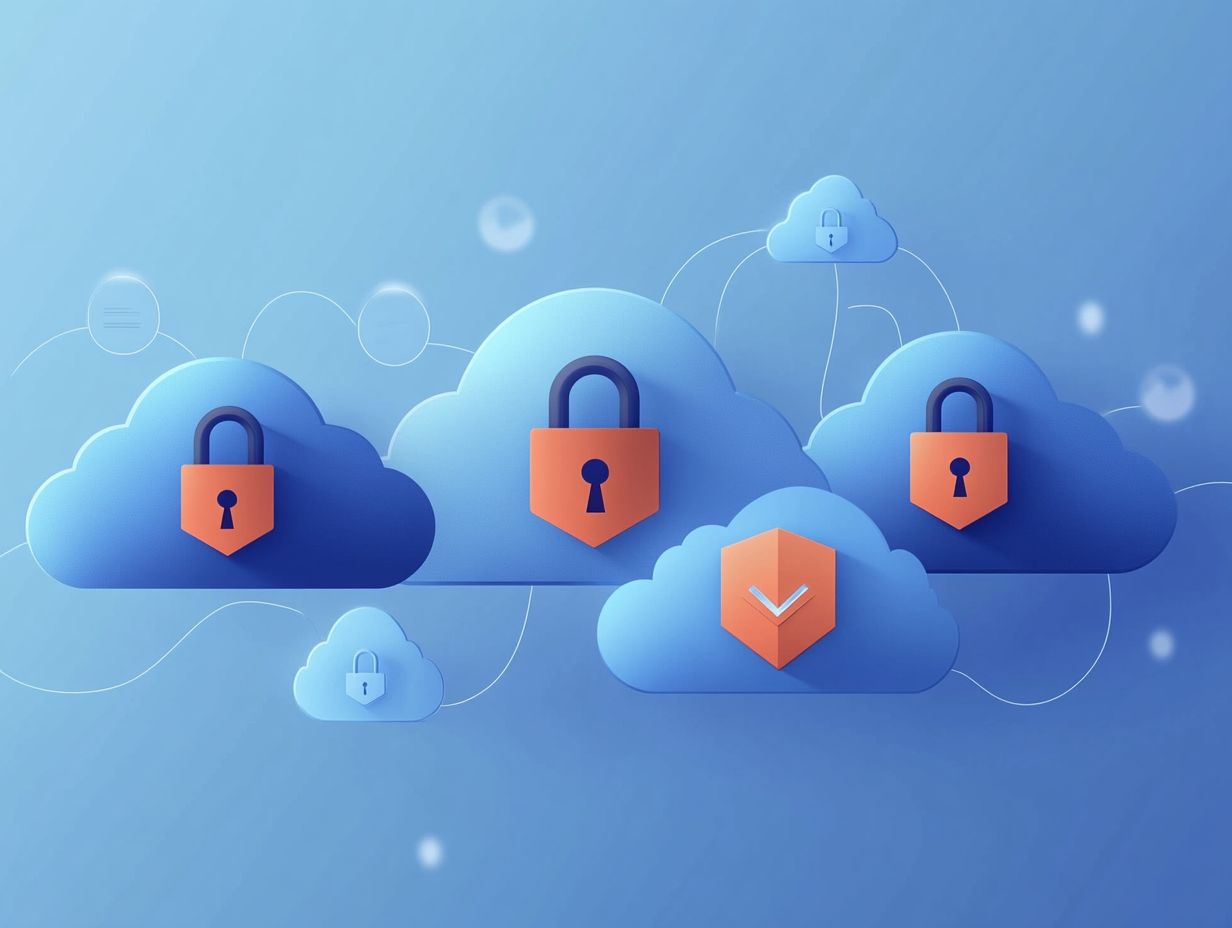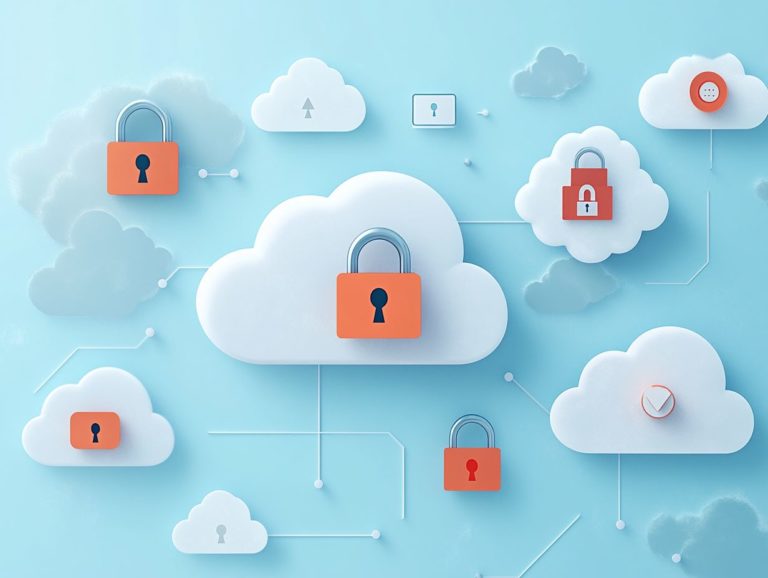5 Cloud Security Myths Debunked
In today s digital landscape, cloud security brims with misconceptions, posing potential pitfalls for businesses of all sizes.
Many still see the cloud as insecure, despite its growing use. These myths can cloud your judgment and impede effective decision-making.
This article debunks five prevalent myths about cloud security, explores its importance, and offers actionable insights to help you keep your data safe and sound.
Prepare to challenge your assumptions and uncover why understanding cloud security is indispensable in our tech-driven world.
Contents
Key Takeaways:

- The cloud is as secure, if not more secure, than traditional systems.
- Cloud security is a shared responsibility; businesses must also manage their security.
- Small and medium-sized businesses can and should take advantage of cloud security.
1. The Cloud Is Not Secure
Despite the increasing reliance on cloud computing, many still view the cloud as inherently insecure. This mindset is one of the most persistent security myths in the digital landscape.
However, when you delve into the complexities of cloud security, like insider threats and misconfigurations, you ll discover that a well-managed cloud environment can actually enhance your organization s security posture through advanced encryption techniques and careful monitoring of threats.
This perception often arises from misunderstandings fueled by high-profile data breaches. While these incidents are alarming, they don’t accurately represent the security capabilities of modern cloud systems. More often than not, misconfigurations or human errors are the culprits, underscoring the critical need for proper configurations and continuous monitoring.
Cloud security has improved a lot, now incorporating multi-factor authentication, automated compliance checks, and regular audits. These advancements directly address common concerns about insider threats and unauthorized access.
By becoming familiar with these robust measures, you can mitigate risks and confidently leverage cloud solutions, creating a culture where security is prioritized and well understood.
2. Cloud Providers Are Responsible for All Security
A common misconception is that cloud providers bear the entire burden of security. However, the shared responsibility model clarifies that while these providers implement robust security measures, it s crucial for you to take charge of your own IT security, compliance regulations, and infrastructure managed by your DevOps team.
This model clearly shows who is responsible for what: cloud providers typically protect the physical infrastructure, such as data centers and virtualization technologies, while you are responsible for securing your applications, data, and user access controls.
If you operate within the European Union, you must ensure compliance with regulations like GDPR, which sets forth stringent guidelines for data protection and privacy. If you work in healthcare, you must follow HIPAA regulations, which require close collaboration between you and the cloud provider to maintain patient data confidentiality.
This framework illustrates the dual facets of accountability that come into play.
3. Cloud Security Is Only for Big Businesses
The notion that cloud security is solely for large enterprises is a misconception. In reality, small businesses stand to gain immensely from implementing robust cloud security measures, including data protection policies that effectively mitigate risks associated with advanced threats and ensure compliance with pertinent regulations.
These security measures like multi-factor authentication, encryption, and regular security audits are becoming increasingly accessible. Studies indicate that around 60% of small to medium-sized enterprises experience a data breach within just six months of migrating to the cloud.
By leveraging tools designed specifically for smaller operations, such as managed threat detection services and automated backup solutions, these businesses can effectively protect their sensitive information.
Case studies have shown that small companies adopting comprehensive cloud security strategies have experienced a remarkable 30% reduction in security incidents, highlighting the critical importance of investing in such protective measures.
4. On-Premise Solutions Are More Secure

Many believe on-premise solutions are inherently more secure than cloud environments. This view misses the rapidly changing landscape of cyber threats.
Cloud security can actually provide strong vulnerability management and regular security audits. It also defends against advanced threats like DDoS (Distributed Denial of Service) attacks and malware.
On-premise systems require heavy investments in security infrastructure. This can lead to protection gaps and delays in updates.
In contrast, cloud environments are monitored and updated by specialized teams. This ensures security measures remain current against the latest threats.
Cloud solutions are scalable, allowing deployment of advanced security tools without high upfront costs. As threats grow more sophisticated, cloud security offers a comprehensive framework for quick responses to new challenges.
5. Cloud Security Is Too Expensive
The idea that cloud security is too costly is often exaggerated. Many providers offer budget-friendly solutions with essential features like cloud backups and automated security.
Switching to cloud security can cut overhead costs significantly. You no longer need extensive in-house infrastructure or a dedicated security team.
For instance, after adopting cloud security, costs related to physical servers and maintenance can drop drastically. Investing in these measures helps mitigate potential data breach losses, which can be thousands or millions in fines and legal fees.
Moving to cloud security not only streamlines operations but also enhances resilience against threats. This investment brings extensive benefits.
What Is Cloud Security and Why Is It Important?
Cloud security involves the policies, technologies, and controls that protect data and applications in a cloud environment. Implementing effective measures prevents data breaches and ensures compliance with regulations.
In today s digital world, where sensitive information is stored online, strong cloud security is essential. With rising cyber threats, protecting your data’s confidentiality, integrity, and availability is critical.
Non-compliance can lead to serious financial penalties and damage your reputation. To reduce these risks, adopt best practices like:
- Strong access controls
- Regular audits
- Utilizing encryption
- Employee training for security awareness
What Are the Common Misconceptions About Cloud Security?
Many misconceptions exist, such as the belief that cloud security is inherently insecure. Addressing these top cloud security myths is vital for an effective security strategy.
Misunderstandings often cause organizations to overlook the robust safeguards that cloud providers implement. Well-configured cloud environments can be more secure than traditional IT infrastructures.
The belief that data loss is common in the cloud ignores the backup solutions offered by many providers. By clearing up these myths, you can develop better security practices and enhance your resilience against potential breaches.
How Can Businesses Ensure the Security of Their Cloud Data?

To ensure the security of your cloud data, implementing complete security steps is crucial. This includes robust data protection policies, proactive management of weaknesses, and continuous threat intelligence practices that evolve with the ever-changing landscape of cyber threats.
These essential actions form the bedrock of a secure cloud environment. Regular audits are essential, enabling you to assess your security posture and identify potential weaknesses before they can be exploited.
Investing in employee training empowers your team with the knowledge to recognize and respond to threats effectively. By establishing well-defined incident response plans, you can ensure a swift reaction to any breaches, minimizing both damage and recovery time.
Integrating advanced cloud security tools significantly bolsters your defenses, adding layers of protection against unauthorized access and data loss.
What Are the Benefits of Cloud Security?
Cloud security offers a wealth of benefits that can elevate your organization, including enhanced protection against advanced threats, cost savings through automated security, and increased efficiency in managing security measures all without the cumbersome overhead of traditional IT infrastructures.
These advantages not only safeguard your sensitive data but also empower you to operate more resiliently in a rapidly evolving digital landscape.
Consider a leading financial institution that adopted cloud security solutions. They not only shielded their customer data from potential breaches but also slashed their operational costs by 30%.
A tech startup used automated security protocols in the cloud to streamline compliance with regulations. This enabled them to launch new products at an accelerated pace while maintaining rigorous security standards.
These examples show that integrating cloud security not only transforms IT practices but can be a game-changer for your entire business strategy, driving innovation and fostering trust with your clients.
What Are the Risks of Neglecting Cloud Security?
Ignoring cloud security puts your organization at serious risk. You’re exposed to data breaches, regulatory issues, and malware threats. The consequences can be dire, resulting in substantial financial losses and irreparable reputational damage.
A recent study revealed that 60% of small businesses that experience a cyberattack shutter their doors within just six months. Take the notorious Capital One data breach of 2019, which compromised the personal data of over 100 million customers due to a misconfigured firewall.
These instances highlight how insufficient cloud security can lead to catastrophic outcomes. It s imperative for organizations to take a proactive stance in managing their cloud environments.
By implementing robust security measures, regularly monitoring systems, and investing in personnel training, you can substantially reduce these risks and protect your invaluable data from emerging threats.
How Can Businesses Stay Informed about Cloud Security?
You can stay ahead in cloud security by engaging with threat intelligence sources, adhering to compliance regulations, and regularly conducting security audits. This proactive approach will keep you informed about evolving threats and best practices.
Consider leveraging specialized resources like the Cloud Security Alliance and reputable cybersecurity publications such as SC Magazine or Dark Reading. These platforms offer valuable insights into the latest trends and emerging threats.
Participating in online forums and communities, such as Reddit s r/netsec or specialized LinkedIn groups, allows you to engage in meaningful discussions and share knowledge with peers.
Pursuing industry certifications like Certified Cloud Security Professional (CCSP) or CompTIA Security+ equips your team with the necessary skills to identify vulnerabilities and implement robust security measures.
Ongoing education is vital, empowering your teams to adapt and respond effectively to the rapidly evolving landscape of cloud security.
Start implementing these strategies today to protect your organization and its valuable data!
Frequently Asked Questions

What are the top 5 cloud security myths?
The top 5 cloud security myths are: 1) The cloud is not secure, 2) Data is more vulnerable in the cloud, 3) Cloud providers are responsible for all security, 4) Compliance is not possible in the cloud, and 5) cloud services are too expensive.
Is the cloud really not secure?
Many people believe the cloud is not secure. In reality, the cloud can be just as secure, if not more secure, than traditional on-site systems.
Cloud providers have expert teams focused on security and regularly update their systems to protect against new threats. This means the cloud often provides better security than individual organizations can achieve alone.
How does cloud security compare to on-site security?
Cloud security tends to be more robust than on-site security. Cloud providers have strict security protocols, such as encryption and access controls, to keep data safe.
Are cloud providers solely responsible for all security?
No, security is a shared responsibility. While cloud providers maintain system security, organizations must implement their own security measures to protect their data.
Is it possible to maintain compliance in the cloud?
Yes, many cloud providers offer compliance certifications and undergo regular audits. Using a certified cloud provider makes it easier for organizations to maintain compliance.
Are cloud services too expensive?
Don’t let the initial costs scare you! Transitioning to the cloud can save you money in the long run.
By eliminating the need for on-site hardware and maintenance, organizations can cut overall IT costs. Plus, the added security and compliance benefits can save them from costly data breaches.






